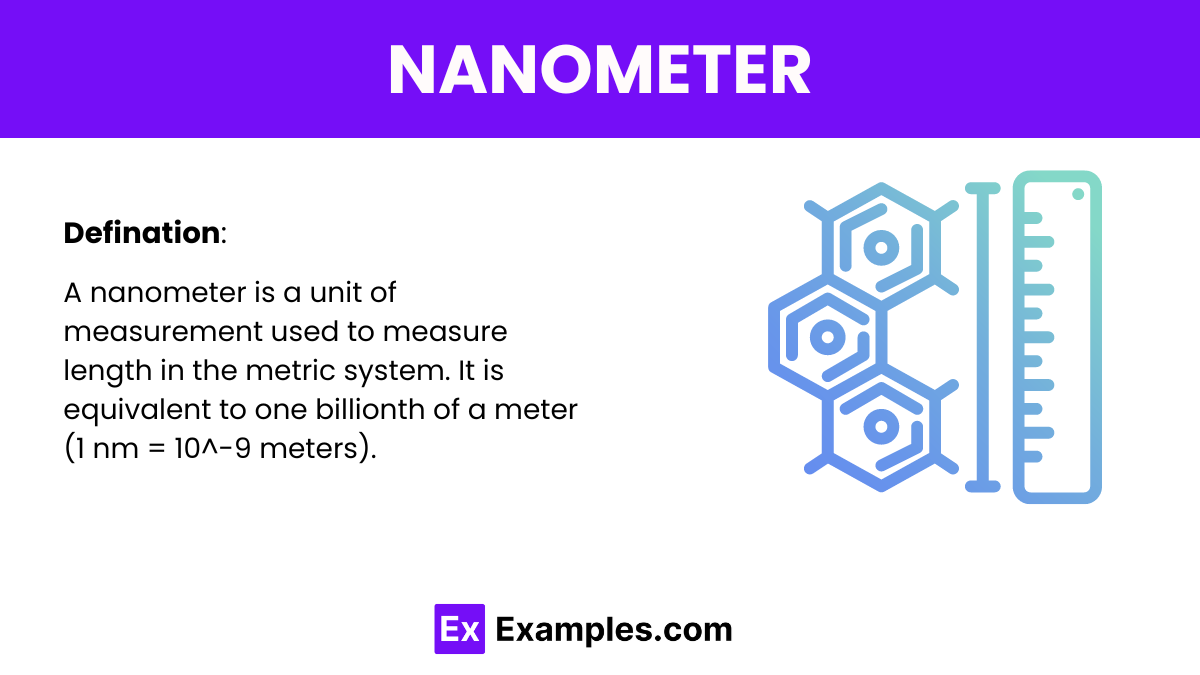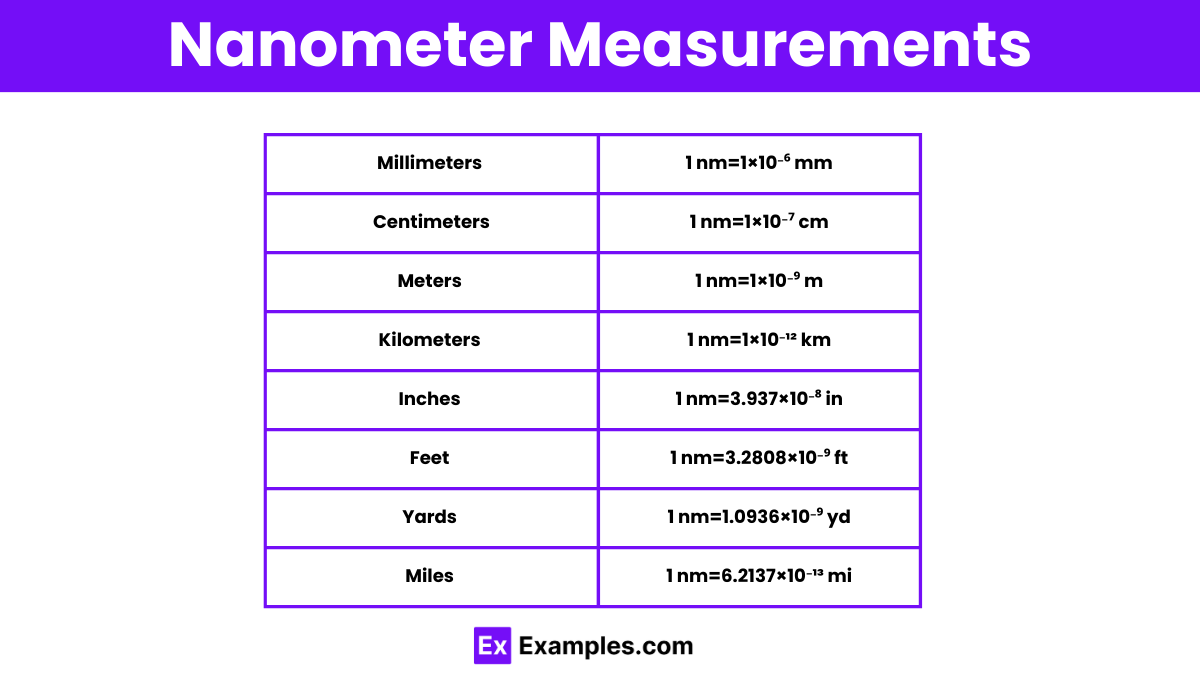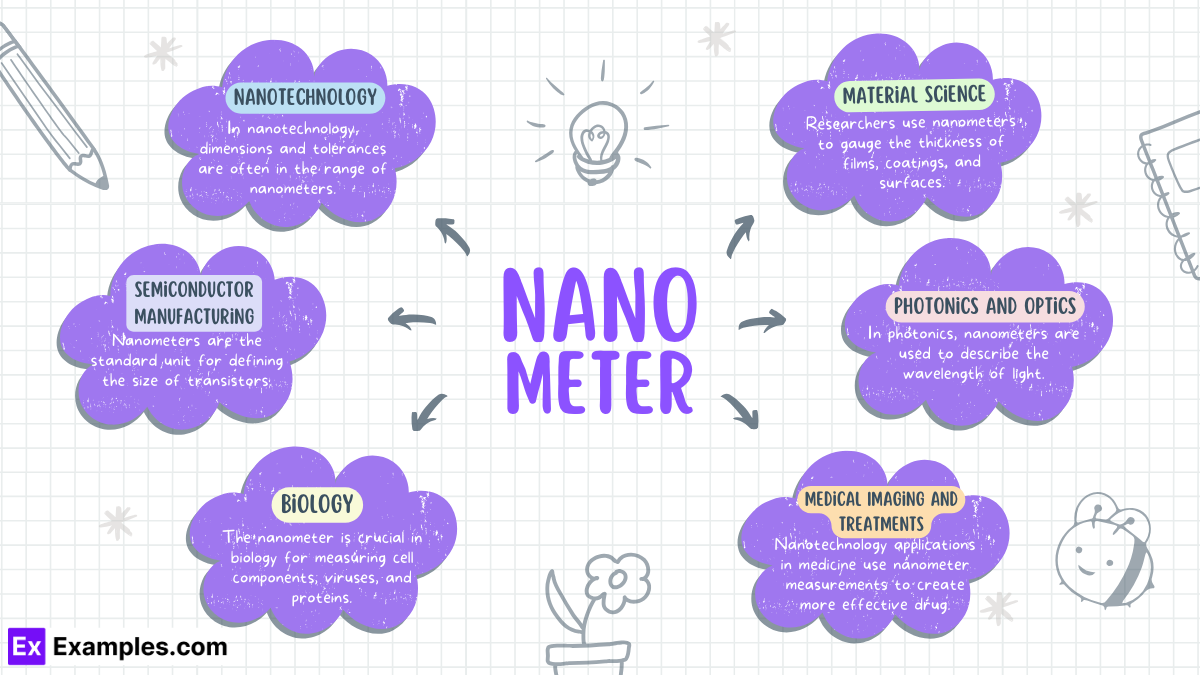What is the length of one nanometer in meters?
1×10⁻⁷
1×10⁻⁹
1×10⁻¹⁰
1×10⁻¹²

A nanometer is a unit of length in the metric system, equivalent to one billionth of a meter (10^-9 meters). It is commonly used to measure things at the atomic and molecular scale, such as the wavelengths of electromagnetic radiation, the sizes of biological structures and molecules, and the dimensions of semiconductor components. This unit is fundamental in fields like nanotechnology, physics, and chemistry.
A nanometer is a unit of measurement used to measure length in the metric system. It is equivalent to one billionth of a meter (1 nm = 10^-9 meters).Due to its extremely small scale, the nanometer is most commonly used in science and technology to measure things like the wavelengths of light, the sizes of molecules and atoms, and the dimensions of components in nanotechnology and electronics.
Measuring dimensions on the scale of nanometers requires highly specialized tools, as these measurements are far too small to be seen with the naked eye or conventional measuring devices. Here are some of the tools and techniques commonly used to measure in nanometers:

Here’s a table showing the conversion of nanometers (nm) to other common units of length:
| Length Unit | Conversion from Nanometers (nm) |
|---|---|
| Millimeters (mm) | 1 nm=1×10⁻⁶ mm |
| Centimeters (cm) | 1 nm=1×10⁻⁷ cm |
| Meters (m) | 1 nm=1×10⁻⁹ m |
| Kilometers (km) | 1 nm=1×10⁻¹² km |
| Inches (in) | 1 nm=3.937×10⁻⁸ in |
| Feet (ft) | 1 nm=3.2808×10⁻⁹ ft |
| Yards (yd) | 1 nm=1.0936×10⁻⁹ yd |
| Miles (mi) | 1 nm=6.2137×10⁻¹³ mi |
Understanding how to convert nanometers to other units of length is essential for working accurately in fields like nanotechnology, physics, and materials science. Here’s a straightforward guide to converting nanometers to and from other common units of length:

The nanometer (nm) is a unit of measurement often used in fields where extreme precision is crucial, especially at the molecular or atomic level. Here are several key uses of nanometers:
One nanometer is about the length that a fingernail grows in one second. It’s also approximately ten times the diameter of a hydrogen atom.
No, the human eye cannot see objects at the nanometer scale. Nanometers are far smaller than the wavelengths of visible light, making them invisible to the naked eye.
Smaller than 1 nanometer are the picometer (1 nm = 1,000 pm) and the femtometer (1 nm = 1,000,000 fm), which measure atomic nuclei and subatomic particles, respectively.
One nanometer (nm) is equal to one billionth of a meter, precisely 0.000000001 meters or 10−910−9 meters. It is commonly used to measure atomic and molecular dimensions.
Text prompt
Add Tone
10 Examples of Public speaking
20 Examples of Gas lighting
What is the length of one nanometer in meters?
1×10⁻⁷
1×10⁻⁹
1×10⁻¹⁰
1×10⁻¹²
How many nanometers are there in one micrometer?
100
1,000
10,000
100,000
What is the nanometer scale typically used to measure in technology?
Visible light wavelengths
Atomic nuclei
Bacterial sizes
Human hair thickness
Which of the following devices uses nanometer technology?
Microphones
Nanoparticles
Solar panels
Optical lenses
What is the typical size range of a virus in nanometers?
10 to 100 nm
100 to 1,000 nm
1,000 to 10,000 nm
10,000 to 100,000 nm
In semiconductor manufacturing, what is the significance of a 7 nm process node?
It refers to the thickness of the material.
It is the width of the smallest feature that can be manufactured.
It measures the size of the overall chip.
It indicates the power consumption of the chip.
What is the approximate thickness of a DNA molecule in nanometers?
1 nm
2 nm
3 nm
4 nm
What does a nanometer measure in terms of length?
1 billionth of a meter
1 millionth of a meter
1 thousandth of a meter
1 hundredth of a meter
What is the typical size range of a human hair in nanometers?
10,000 to 100,000 nm
1,000 to 10,000 nm
100 to 1,000 nm
10 to 100 nm
How does the wavelength of ultraviolet light compare to that of visible light in nanometers?
UV light has a longer wavelength.
UV light has a shorter wavelength.
UV light and visible light have the same wavelength.
UV light’s wavelength is not measurable in nanometers.
Before you leave, take our quick quiz to enhance your learning!

